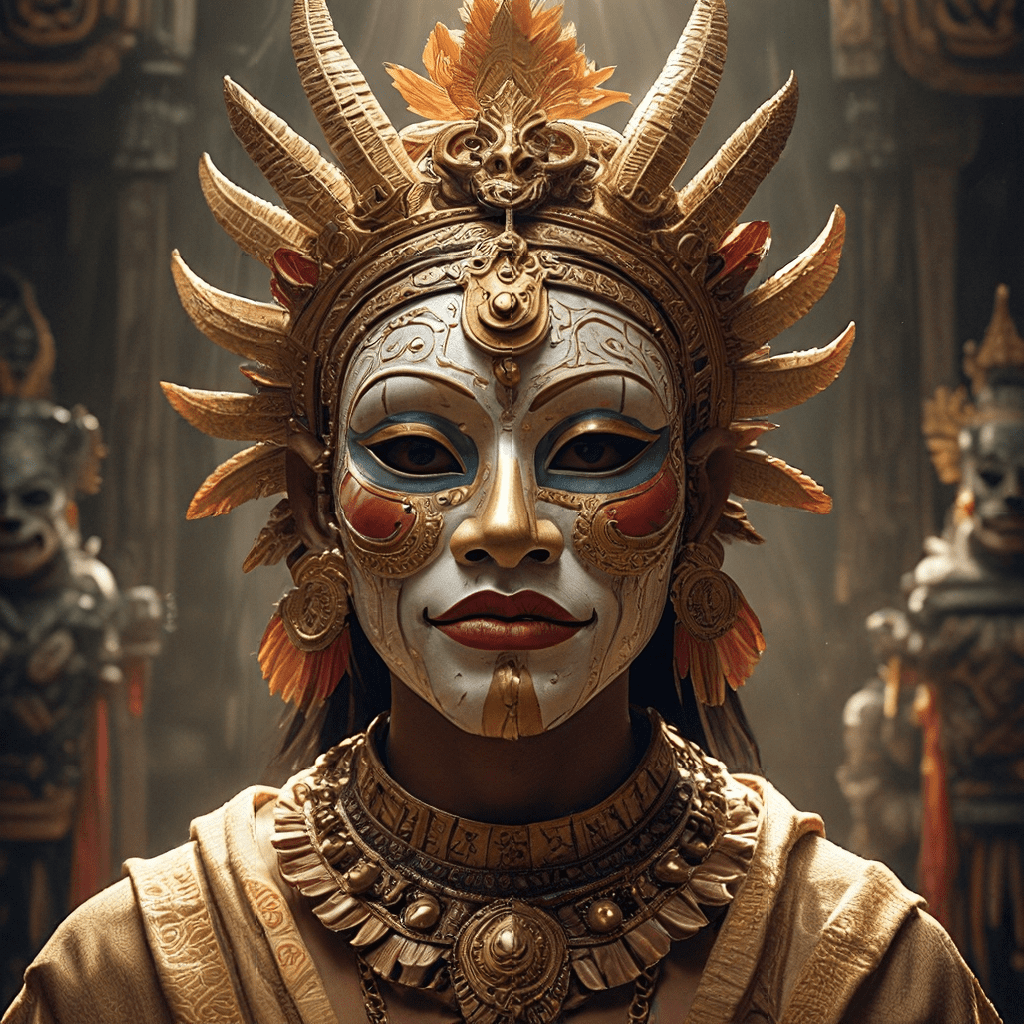The Significance of Ritual Masks in Filipino Mythological Practices
1. Diverse Filipino Mythologies: A Tapestry of Beliefs
The Philippines, an archipelago of over 7,000 islands, boasts a rich and diverse tapestry of indigenous mythologies. These mythologies, passed down through generations, reflect the unique beliefs and traditions of different Filipino ethnic groups. Each group harbors a distinct set of stories, legends, and rituals that reflect their understanding of the world, the supernatural, and their place within it. These mythologies are woven into the fabric of Filipino culture, influencing everything from daily life to artistic expressions.
Filipino mythology is a vibrant mosaic of diverse beliefs. It is a treasure trove of stories about gods and goddesses, mythical creatures, spirits, and ancestral beings. These stories offer explanations for natural phenomena, societal norms, and personal experiences. They provide a framework for understanding the world and navigating its challenges.
Some of the most prominent deities in Filipino mythology include Bathala, the supreme creator god, and the powerful spirits of nature, such as the diwatas, or fairies, and the engkantos, or nature spirits. These divine beings often intervene in the lives of mortals, granting blessings, dispensing justice, or punishing wrongdoing.
2. Ritual Masks: Guardians of the Sacred Realm
In this rich tapestry of beliefs, ritual masks play a pivotal role. They are more than mere decorative objects; they serve as powerful symbols, embodying the essence of the sacred realm. Across the various indigenous cultures of the Philippines, ritual masks are used in a wide range of ceremonies and rituals, from fertility rites to ancestor veneration to healing ceremonies.
These masks are crafted from various materials, including wood, metal, and fiber. They often feature intricate designs, vibrant colors, and symbolic elements that reflect the specific beliefs and traditions of each community. Their forms are often inspired by animals, spirits, or deities, reflecting the close connection between nature, spirituality, and human existence.
The creation of ritual masks is a sacred art form, often passed down through generations within families or communities. The process of crafting a mask is itself a ritual, imbued with reverence and a deep understanding of the symbolic power it represents.
3. Functions of Ritual Masks in Filipino Mythological Practices
Ritual masks serve a multitude of functions within Filipino mythological practices, acting as conduits between the human world and the spiritual realm. They serve as powerful tools for communication with the supernatural, facilitating interactions with spirits, ancestors, and deities. They are used in ceremonies to invoke blessings, ward off evil spirits, and ensure the well-being of the community.
4. Masks as Representations of Ancestral Spirits and Deities
The forms of many ritual masks represent the spirits of ancestors or deities. These masks serve as visual representations of these powerful beings, enabling individuals to connect with their spiritual essence. By donning these masks, performers embody the spirits, channeling their energy and communicating their messages to the community.
5. Masks as Symbols of Power and Authority
Ritual masks are also powerful symbols of power and authority. They often represent the position of leaders, shamans, or other figures of significance within the community. By wearing these masks, individuals assume a heightened status, embodying the power and authority entrusted to them.
6. The Role of Masks in Shamanistic Practices
In many Filipino cultures, shamans, or spiritual healers, play a crucial role in connecting with the spiritual realm. Ritual masks are essential tools in their practices, aiding them in their journeys to the spirit world and their interactions with spirits. During healing ceremonies, shamans might wear masks representing specific spirits or deities to invoke their power and guidance in addressing illnesses or other challenges. The masks act as intermediaries, facilitating the flow of energy and information between the shaman and the spiritual realm. They allow shamans to access the knowledge and power of the spirits, enabling them to heal the sick, protect the community, and maintain harmony between the human and spiritual worlds.
7. Masks as Facilitators of Transformation and Communication with the Supernatural
Ritual masks are more than mere objects; they serve as powerful tools for transformation and communication with the supernatural. By donning a mask, a performer undergoes a symbolic transformation, embodying the essence of the spirit or deity it represents. This act allows for a deeper connection with the spiritual realm, opening channels for communication, receiving guidance, and enacting the will of the spirits.
The masks serve as visual representations of the spiritual world, helping to bridge the gap between the material and the immaterial. They allow individuals to access the power and wisdom of the supernatural, seeking protection, guidance, and blessings. The act of wearing a mask is a ritual in itself, a symbolic journey into the realm of the spirit world.
8. Theories on the Origins and Development of Filipino Ritual Masks
The origins of Filipino ritual masks are deeply rooted in their indigenous beliefs and practices. These masks have evolved over centuries, reflecting the changing cultural landscapes and the influence of various external forces. Some theories suggest that the earliest masks were inspired by natural forms, such as animals, plants, and celestial bodies. These early masks likely served practical purposes, such as hunting or ritualistic ceremonies.
Over time, the symbolism and function of Filipino ritual masks became increasingly complex, reflecting the evolving beliefs and practices of different communities. The influence of animistic beliefs, which acknowledge the presence of spirits in all things, played a significant role in the development of these masks. They served as visual representations of spirits, ancestors, and deities, embodying their power and influence.
9. The Influence of Indigenous Beliefs and Foreign Cultures
Filipino ritual masks, like many aspects of their culture, reflect a blend of indigenous beliefs and influences from other cultures. Precolonial Filipino communities held strong beliefs in the spirits of nature, ancestors, and deities, reflected in the masks used in their ceremonies. The arrival of foreign cultures, such as the Spanish and the Americans, introduced new religious beliefs and artistic influences, enriching the tradition of mask making.
The blending of indigenous and foreign influences resulted in the development of unique forms and styles of masks across different regions of the Philippines. Some masks incorporate elements from both native and foreign traditions, creating a visual tapestry that reflects the rich cultural history of the islands.
10. The Enduring Legacy of Ritual Masks in Contemporary Filipino Society
Despite the passage of time and the influence of modern society, Filipino ritual masks remain an integral part of their cultural heritage. They continue to be used in traditional ceremonies, festivals, and performances, connecting generations to their ancestral beliefs and traditions. The crafting of these masks remains an important art form, passed down from one generation to the next, preserving the rich history and symbolism embedded within them.
In contemporary Filipino society, the significance of these masks extends beyond their traditional roles. They have become symbols of Filipino identity, representing the resilience, creativity, and spirituality of the Filipino people. They are featured in museums, galleries, and cultural centers, serving as reminders of the rich heritage that continues to influence the lives of Filipinos today.
FAQ
Q: What is the significance of the colors used in Filipino ritual masks?
A: Colors play a significant role in Filipino ritual masks, often carrying symbolic meanings specific to the culture or community. For example, red might represent blood, sacrifice, or power, while yellow could symbolize prosperity or the sun.
Q: Are there any specific types of Filipino ritual masks that are particularly well-known?
**A: **Yes, there are many well-known types of Filipino ritual masks, each with its unique characteristics and symbolism. Some of the most famous include the "Maskara" from the Sinulog Festival in Cebu, the "Manunggul Jar" mask representing a boatman's journey to the afterlife, and the "Sigbin" mask, which represents a mythical creature with a mischievous nature.
Q: Are Filipino ritual masks used for anything other than ceremonies and rituals?
A: While Filipino ritual masks are primarily used in ceremonies and rituals, their influence extends beyond religious practice. They are also incorporated into art, literature, and popular culture, serving as symbols of Filipino heritage and identity. They are often used in theatrical performances, dance, and contemporary art, representing the enduring power of these traditional symbols.



